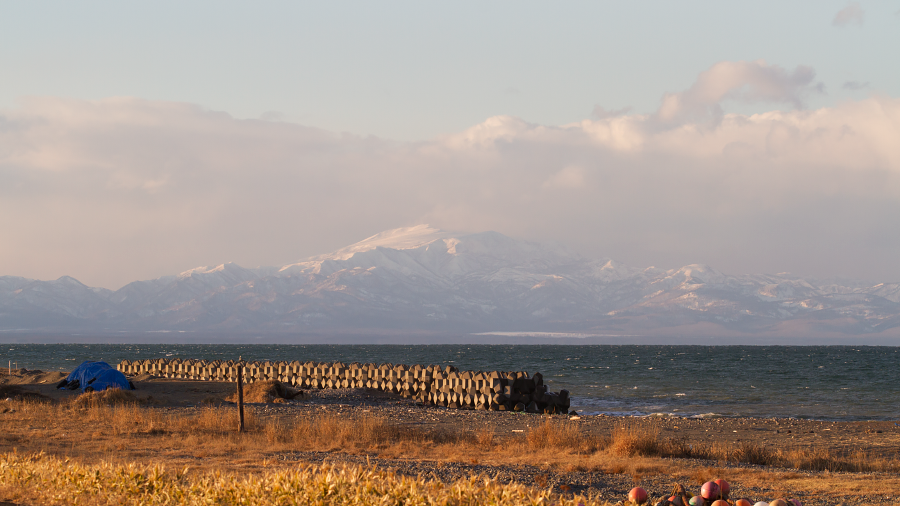27 December 2015
We awoke to find that there had been another dusting of snow overnight and a selection of common species were feeding avidly at the guesthouse feeders during breakfast. A White-tailed Eagle flew over as we left - the first of many eagles we were to see throughout the day.
After enjoying excellent views of Lake Kussharo from the north, the road to Abashiri soon produced the first Steller's Sea Eagles (and a White-tailed) along the route. The scenery along this road is absolutely stunning, as it is around much of northern Hokkaido, and the mulitude of spectacular wintry vistas is a highlight in itself.
Great vista from the road north of Lake Kussharo
There had clearly been a fair bit more snow on Hokkaido's north coast and it was a few degrees colder here to boot. We were pleased to find six Falcated Ducks, including four drakes, on the river in Abashiri - easily our best views of the trip of this stunning duck. There were also numerous Goldeneye and Greater Scaup here.
I'd done some genning in the days leading up to our Hokkaido visit and established that two desirable species had been seen recently at nearby Cape Notoro. The approach road to the lighthouse immediately produced one of these - a cracking Northern Shrike hunting from roadside wires and seemingly unbothered by the north-westerly gale battering the Cape. Though annual on Hokkaido it is rather rare and isn't something visitors should expect to see, so was a pleasing bonus.
sibiricus Northern Shrike at Cape Notoro
I think it was fair to say the Cape was the coldest place that I've ever set foot in my life. Temperatures were sub-zero but the wind made birding (and even standing) extremely hard work, despite several layers of clothing and barely any exposed skin. Needless to say we couldn't find our other target species, Asian Rosy Finch, but both Steller's and White-tailed Eagles drifted by, seemingly nonplussed by the conditions. A distant hovering buzzard was unfortunately an Eastern rather than Rough-legged. Harlequins were abundant offshore (well in to three figures) while two Stejneger's Scoters were the first I'd seen since the Irish bird and a few Glaucous Gulls drifted by. A single alcid picked out transpired to be a Brünnich's Guillemot.
Cape Notoro
Returning to Abashiri port, we found that the fishing fleet was in for the winter and gull numbers were low, though a 1cy Glaucous x Glaucous-winged often showed well alongside a pure Glaucous and several Harlequins also came quite close.
1cy Glaucous (top) and Glaucous x Glaucous-winged Gulls, Abashiri Port
Moving slightly east to Lake Tofotsu 'swan park', we found the lake almost entirely frozen but the ice-free outflow supported good concentrations of birds. It had started to snow again and three Steller's Sea Eagles looked impressive stood on the ice while four Red-crowned Cranes were a surprise. Among the wildfowl were several Harlequins and a few Goosanders as well as the ubiquitous Whooper Swans. A Red-necked Grebe was also present but we could not find the vagrant Cackling Goose that had been photographed here on Christmas Day. A highlight was feeding Pintail out the hand - the poor things were visibly shivering and frankly I'm at a loss as to why they attempt to brave the bitter winters up here when they could simply fly south ...
We checked a smaller frozen lake back towards Abashiri but the goose was not among the 100 Whooper Swans there. Two of the world's most handsome ducks, a drake Smew and a drake Harlequin, were found alongside each other at the outflow there was one of the memorable sights of the trip.
Perhaps the two most beautiful ducks in the world? Sadly they never glanced around at the same time.
As we continued east towards Shari the weather improved and the final couple of hours of daylight turned out bright. A good selection of gulls at the river mouth included the highest concentration of Glaucous we'd seen so far, with at least 15 among the Slaty-backs. Wildfowl included around 100 Scaup and smaller numbers of Wigeon.
Adult Glaucous with other gulls at Shari Port
We were conscious of the time, knowing we needed to be at Yoroushionsen for dusk. One thing we'd learnt was that our Sat Nav predicting much longer journey times than in real life and we made it to Yuyado-Daiichi in good time, putting our bags down and enjoying a coffee as it went dark.
We couldn't quite believe the script here. Watching the owner stock a small pond with fish less than ten metres from where we were sat, separated by nothing more than a pane of glass, it seemed scarcely believable that the world's largest owl might be enticed by this setup. Yet that's exactly what happened some time before 17:15, when a Blakiston's Fish Owl emerged from the darkness, somewhat shocking us with its sheer size as it arrived at the pond and began to fish. It performed extremely well for several minutes and not long after was replaced by a second bird, giving equally as incredible views. One of the birds (apparently the male) has a damaged left eye and has been regular here for over 10 years!
We enjoyed a few more showings (one of which interrupted our fantastic evening meal) before the Owls seemingly shut up shop for the evening; after the last sighting at 20:30 we did not get another sniff by midnight and so retired for the night.





















































